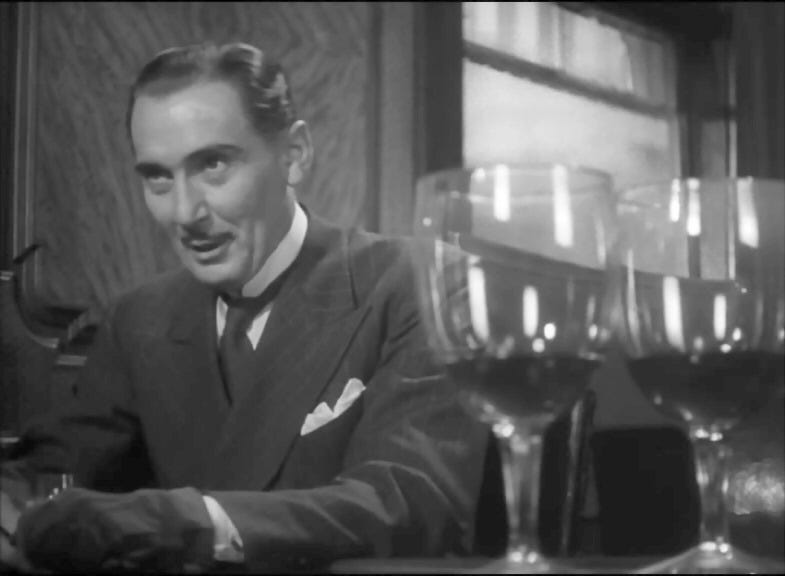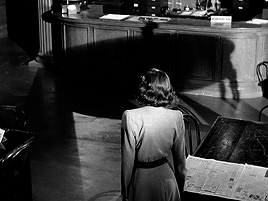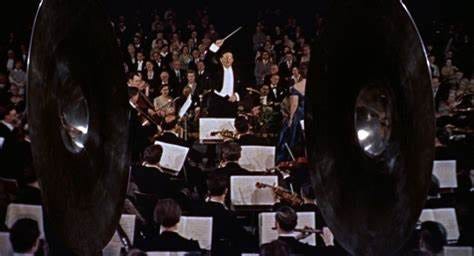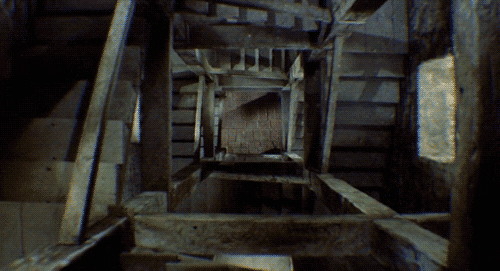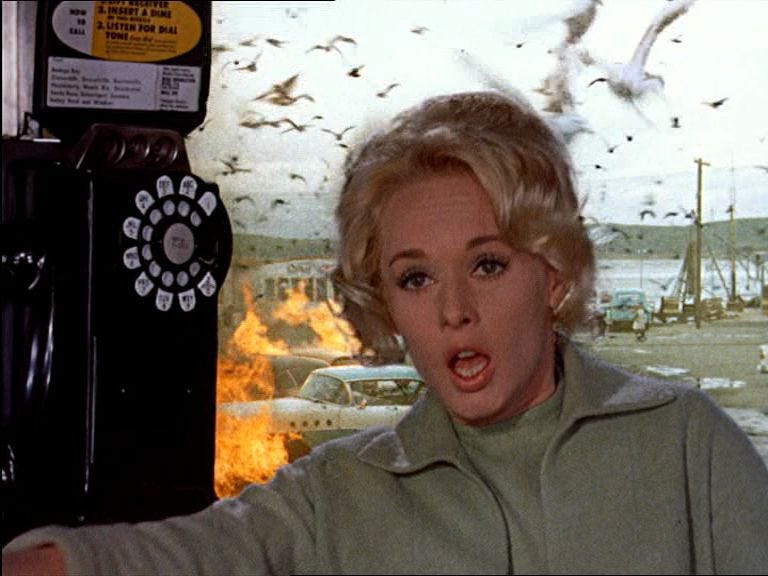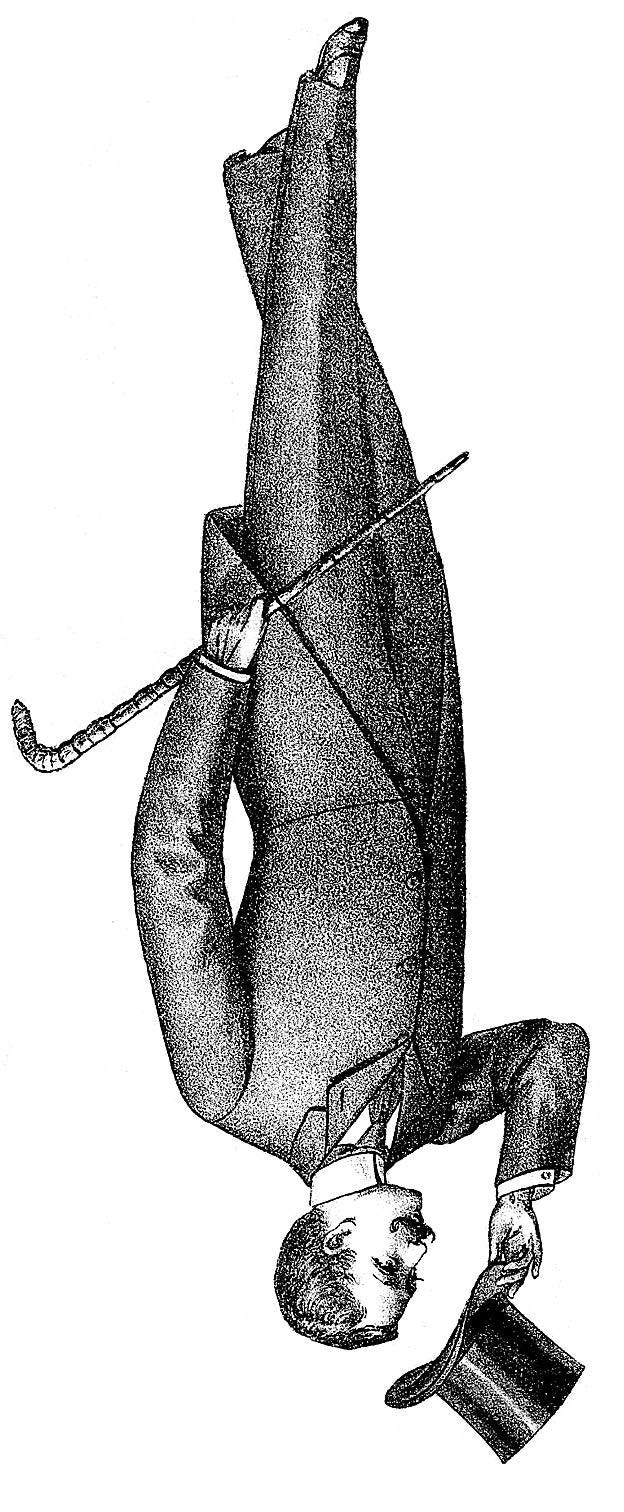The Lodger (1927)
Hitchcock’s first films were not very successful. Still, Michael Balcon, his boss at the time, saw promise in the new director and gave him more work. The Lodger: A Story of the London Fog (1927) was Hitchcock’s first thriller and major success.
The movie was based on a 1913 novel by Marie Belloc Lowndes. A landlady (Marie Ault) suspects the man to whom she rents a room (Ivor Novello) is a Jack the Ripper-type serial killer. Meanwhile, her daughter, Daisy (June Tripp), becomes infatuated with him.
The Lodger is a silent film. As such it is told through visuals and the occasional intertitle. The expressionism that Hitchcock picked up during his time in Germany is apparent. June Tripp recalls:
Fresh from Berlin, Hitch was so imbued with the value of unusual camera angles and lighting effects with which to create and sustain dramatic suspense that often a scene, which would not run for more than three minutes on the screen, would take a morning to shoot.
As an example of an “unusual” angle, the camera looks straight down the stairwell as we see a hand sliding down the banister. It is the lodger sneaking out at night. But the landlady is awakened.
The following scenes are, as Philip Kemp describes them, fluently crosscut. It is 65 shots totaling about six minutes uninterrupted by intertitle cards. With the lodger absent the landlady snoops through his room. She finds a locked cabinet. In the middle of this sequence, Hitchcock cuts to the next murder then back to the snooping woman. She is still in his room as we see the key unlocking the front door, leading the audience to believe she will be caught. Alas, she escapes but, as Kemp points out, “her repeated worried glances, straight into the camera as if involving the audience in her misgivings, tell us that her suspicions haven’t dissipated.”
The movie is most famous for its “glass ceiling” device. The lodger’s host family is downstairs and uneasily watching the swinging chandelier as he paces heavily across his room. Because there is no sound, Hitchcock ingeniously visualizes the footfalls: the ceiling fades so that we see, through a one-inch-thick sheet of plate glass, the bottoms of Novello’s feet pacing.
The Lady Vanishes (1938)
The Lady Vanishes was another early success for Hitchcock. It cemented American producer David O. Selznick’s belief that the director had a future in Hollywood. Although the story takes place in the fictional country of Bandrika, it is likely a stand in for Nazi Germany.
Ms. Froy (May Whitty) is ostensibly an English governess. In reality she is part of a network of spies. She takes a train back to England but soon vanishes. Her new friend and traveling companion, Iris Henderson (Margaret Lockwood), unravels a convoluted conspiracy to abduct the old lady.
The most famous scene in this film is a superb example of directing the audience. Iris and her friend Gilbert (Michael Redgrave) are closing in on the conspiracy. They share their evidence over drinks with Dr. Hartz (Paul Lukas). However, Hartz is the main villain and has spiked their drinks with a knock-out drug.
Portions of this scene are shot through the prominently displayed wine glasses. When the glasses are not prominently displayed, they still appear somewhere in each shot.
Hitchcock explains the scene was filmed this way to avoid the cliché of having the characters lift the glasses to their lips only to set them back down again and again half a dozen times. He continues:
So, I decided to avoid that cliché and merely leave the wine there, untouched, until the last minute. But in order to keep the audience reminded of it I photographed part of the scene through the two glasses. So that would keep the audience [wondering], “When will they pick up the drugged wine.”
While the audience listens to the dialogue their attention is directed toward the glasses. Knowing the drinks are spiked, the audience is kept in anticipation of what might happen. The tension is finally released when Gilbert and then Iris have their drinks.
Shadow of a Doubt (1943)
Shadow of a Doubt was Hitchcock’s favorite of all his films. It makes the top five in my book. It was set in the real-life town of Santa Rosa, California. It was also shot there. Hitchcock didn’t like location shoots except for this one, according to his daughter, Patty.
Charlotte “Charlie” Newton (Teresa Wright) is a bored teenager dying for some excitement. Then her uncle and eponym, Charles Oakley (Joseph Cotton), pays her a visit. He is pursued by two men and needs to lay low. Before long Charlotte suspects that Uncle Charlie is the “Merry Widow Murderer.”
Hitchcock and his writers created a whale of a villain in Uncle Charlie. There are two scenes in which he explains his psychotic philosophy. They must be watched to be appreciated.
The first takes place at dinner. Hitchcock shoots his villain from the side with the features of his face centered. He slowly zooms into a tight close up as the monologue becomes increasingly morbid. Charlotte objects off camera, “They’re alive! They’re human beings!” Uncle Charlie faces the camera. He is addressing his niece, but he also breaks the fourth wall and speaks directly to the audience, involving us in the scene. “Are they?” he asks.
The second takes place in a seedy bar. Uncle Charlie brings up dreams and nightmares. Coincidentally, a nightmare plays out in the foreground while the background is the dream - that is, people going about their sleepy, little lives unaware of the killer in the room. When the waitress interrupts their conversation, it punctuates Charlotte’s desperate loneliness.
There is a lot of watch the listening in the bar scene, notably the hands. Uncle Charlie wrings a napkin in a manner suggestive of his preferred method of murdering: strangulation. This is spliced with Charlotte’s reactions. Although he says, “... now don’t start imagining things,” that he hides his guilty hands under the table is telling.
Hands come up frequently in this movie. When Uncle Charlie realizes he’ll have to murder his niece, his hands have a kind of convulsion and drop his cigar. An emerald ring that Charlie gifted his niece becomes a crucial bit of evidence. Whenever it may (or may not) play a role in a scene Hitchcock takes the time to focus on Charlotte’s hand.
The best example of this comes near the end of the film. There is a party in Uncle Charlie’s honor. He is about to toast his niece who has just descended the stairs. But Charlie's face falls. The camera zooms in on Charlotte’s hand wearing the ring. The camera cuts back to Uncle Charlie. He averts his gaze; the killer is set back on his heels. The audience momentarily believes he is caught, but the calculating psychopath recovers smoothly.
Earlier, Charlotte had discovered the ring belongs to one of the victims. This proves Uncle Charlie did it. For this revelation Hitchcock said he wanted the camera to “inhale.” The camera moves back and up as Charlotte walks away. The pit that must be in her stomach is teleported into the viewers’ through the camera lens.
Charlotte says she and her uncle are like twins. The idea is later repeated by Uncle Charlie, though in a much darker context. This idea is made explicit by each character going by the same nickname. It is also established visually: the shots that introduce each character are nearly identical. The twin theme comes to a head when Charlotte makes good on her promise to kill Uncle Charlie herself.
The two are wrestling on a train. The scene is a montage of staggering feet, clutching hands, widening eyes and tracks racing down below. The varying lengths of edits draws the struggle out leaving audiences in a state of suspense. It ends with a death that even by today’s standards is shocking.
Dial M for Murder (1954)
For a man who said dialogue was “... photographs of people talking, and bears no relation to the art of cinema,” there is a striking amount of dialogue in his movie Dial M for Murder.
Tony Wendice (Ray Milland) blackmails a former colleague into murdering his unfaithful wife. However, in the struggle Margot Wendice (Grace Kelly) kills her attacker. Tony adapts to the new situation by planting evidence to make it seem as though Margot was the aggressor.
Before the main plot gets underway there is a 22-minute-long exposition scene. Two men in a room talking. There isn’t a note of music until the end. There is barely an emotional outburst. It is just two men in a room talking cordially. Yet, it is a captivating scene. How?
The subject matter has a lot to do with it. Tony explains to Charles Swann (Anthony Dawson) how he discovered his wife’s infidelity, how he initially planned to murder her and inherit her money and how he formulated a better plan to blackmail Swann into doing the crime.
Another factor is the expert acting and choreography. There is a lot of movement in this scene. The actors emote with their body language. They walk around. They create intimacy or distance with their relative positions. Nervous hands slide into pockets. Eyes make contact or avoid it.
But for our purposes, Hitchcock’s use of camera angles and orchestration adds to the interest of the scene.
First, Hitchcock puts the audience in the room by shooting much of the dialogue from a waist or medium shot as the characters sit. This creates the illusion that we are sitting with them. But he also shoots from low angles or even behind furniture as if the camera is sneaking around the room. This technique makes the audience a voyeur to the conspiracy. It communicates that the conversation - ostensibly about buying a car - is actually about something more sinister.
Part of Tony’s persuasion is to befriend Swann. To this end, he sits with him on a couch talking and smiling. However, a table lamp separates them visually indicating they are not friends. Also note how the camera hides.
Second, close ups are reserved for key moments. There are a number of examples but none so dramatic as the “far more sensible idea” moment. Tony says he may have gone through with his plan to murder his wife until he saw “something” that changed his mind. He actually delivers this line twice. The first time Swann doesn’t take the bait, and we get a baffling panning shot of him (I think it is Tony looking Swann over, studying him and waiting for an expected reaction). Anyway, the second time Swann asks, “Well, what did you see?”
“I saw you,” is the reply. There is a medium close up on Swann as he turns around to face the camera. We understand that he now recognizes the trap he’s walked into.
Finally, Hitchcock shoots from a variety of angles. In one instance while Tony is sitting, the camera looks up at him almost through the floor. It gives Tony an aura of control as he manipulates Swann. More interesting is the from-the-ceiling shot as Tony methodically explains the murder plan. This indicates Tony’s detached attitude when discussing the death of his wife. Hitchcock also zooms in from the ceiling to accentuate important plot points such as the hiding place of the latch key.
I would be remiss not to mention the giant prop phone. This is more than an allusion to the title. The extreme close up achieved by this prop reminds the audience of the significance of Tony’s call.
The Man Who Knew Too Much (1956)
I will review the 1956 version of The Man Who Knew Too Much starring Doris Day and the iconic James Stewart. The original film was released in 1934. Joanathan Coe, writing for the British Film Institute, says there is much debate over which one is better. Hitchcock himself said, “The first version is the work of a talented amateur and the second was made by a professional.” While Coe says Hitch struck a “magisterial balance” with this assessment, I tend to think he was firmly on the side of the ‘56 version.
An American family is vacationing in Morocco. While in a market they witness the murder of a French intelligence operative. With his last breaths the operative relays an assassination plot to Dr. Benjamin McKenna (Stewart). Now in possession of this dangerous information, the McKenna family become targets.
The finale takes place in Royal Albert Hall. Parts of it were filmed on location and other parts in a reproduction on a soundstage. The London Symphony Orchestra performed Arthur Benjamin’s Storm Clouds Cantata. The assassin (Reggie Nalder) means to shoot a foreign dignitary at the crash of cymbals near the end of the piece.
The sequence was written with dialogue. However, Hitchcock decided it wasn’t needed. Indeed, we can tell how Ben and wife Jo (Day) try to foil the plot. Ben first goes to the police, but they are useless. He then confronts the assassin himself. The entire sequence runs for 10 minutes without a word spoken until Jo screams causing the shooter to miss his target.
The finale is a variation of Hitchcock’s bomb theory. In this case the bomb is the gun that’ll murder the foreign dignitary. We are shown the assassin sitting in the box, eyeing his target with binoculars. Later, the barrel of his gun emerges from behind a curtain and turns down range.
The ticking clock is the musical score and the orchestra’s conductor, Bernard Hermann. The camera pans across the written notes as the shadow of the conductor’s baton ticks off the beats. We also get a shot of Hermann through the cymbals. In this single, brilliantly framed shot we are reminded of both time running out and what that means.
Of course, Storm Clouds does a lot of the heavy lifting in the building of suspense. Nevertheless, this is a powerful example of what the camera and editing can do.
Vertigo (1958)
The first time I watched Vertigo I found it strange and unappealing. Since then, my appreciation for it has grown. Coincidently, this mirrors the film’s critical history. Initially receiving mixed reviews, it is now considered Hitchcock’s best film by many. Although I wouldn’t go that far, it is worth seeing.
San Francisco detective John “Scottie” Ferguson (James Stewart) retires after a rooftop incident leaves him with severe acrophobia and vertigo. Later, an acquaintance hires Scottie to tail his strangely behaving wife. But the woman he tracks is an imposter and part of an elaborate murder scheme.
This movie marks the invention of an in-camera special effect that was later named for it. The so-called “Vertigo effect” is created by physically moving the camera either backwards or forwards on a dolly while zooming in the opposite direction. It is sometimes called a dolly zoom or a zolly.
The result, as defined by Studio Binder, is a shot in which “the foreground remains in the same position while the background either shrinks or grows depending on the direction of the camera movement.” It has since been used by many famous directors including Steven Spielberg (Cf. Jaws or Poltergeist).
The effect is used in three important scenes.
The first is at the beginning. Scottie and another cop are chasing a suspect over rooftops. They leap from one building to the next. Scottie doesn’t make the jump and dangles from a gutter. His partner tries to help him up, but he falls to his death. The effect is used when Scottie first looks down to communicate his fear of falling.
In the second, Scottie is climbing the stairs of a church tower to prevent his love interest (played by Kim Novak) from committing suicide. But his acrophobia prevents him from reaching the top. Again, Hitchcock uses the Vertigo effect to make the audience feel Scottie’s disorientation and fear.
The third is the finale. Scottie once more climbs the church stairs, but this time overcomes his fear.
North by Northwest (1959)
A film critic said the only problem with North by Northwest is you can only watch it for the first time once. I believe the critic was Roger Ebert, but I haven't been able to confirm that. In any case, I found my second viewing better. I was able to pick up on the subtlety of dialogue and character motivations.
Advertising executive Roger Thornhill (Cary Grant) is mistaken for a government agent. Because of this confusion he is hunted by Phillip Vandamm (James Mason), an enemy spy trying to smuggle secret microfilm out of the United States.
The movie is known for two scenes: the crop duster attack and Mount Rushmore.
The crop duster sequence begins with 8 minutes of nothing happening. Roger stands in the middle of a field. He believes he is there to meet George Kaplan. In reality, he’s been set up. While waiting, a few cars drive by. Boring. Or is it?
The audience is aware of the setup. It’s not a matter of if but when and how Vandamm’s goons will strike. A semi-truck comes barreling down the road. Will it swerve to pulverize Roger? A nondescript car drops off a nondescript man. He just stands there. Roger finally strikes up a conversation with him. What will be revealed? Nothing. The man boards a bus and is gone. It’s knowing that something is about to happen that makes this scene so tense.
Before he goes, the bus rider comments that the crop duster is dusting barren fields. This is not our first glimpse of the plane, but it is our first indication that something is suspicious about it. Sure enough, the plane swoops in and takes shots at Roger.
The Mount Rushmore scene is a playful use of scale and perspective, according to Jim Emerson writing for RogerEbert.com. The presidential faces are in extreme closeups while Hitchcock’s tiny by comparison actors are in long shots.
It ends with Roger saving his love interest, Eve (Eva Marie Saint), from a deadly fall. The sequence becomes dream-like and concludes with Roger pulling Eve up - not from a cliff face but into an upper berth. They are on a train and happily married.
The Birds (1963)
Melanie Daniels (Tippi Hedren) follows Mitch Brenner (Rod Taylor) up to his family farm in Bodega Bay, California. She intends to deliver a pair of lovebirds for his little sister's birthday. As the two strike up a relationship, the local birds inexplicably attack the town.
The film was loosely based on a 1952 story by Daphne du Maurier. However, it was also inspired by a real-life event on August 18, 1961, in Capitola, California. Thousands of birds “called sooty shearwaters, regurgitated anchovies, flew into objects and died on the streets,” according to Live Science. The incident in the movie is never explained. The real one was caused by toxic algae.
After a man is killed, Melanie goes to Bodega Bay School to check on the little sister, Cathy (Veronica Cartwright). The children are busy so she has a cigarette outside near the playground. The shot is framed such that the audience can see the jungle gym behind her and to the left. A single crow lands on it. The camera cuts to Melanie, centering her and hiding the jungle gym.
There are three more cuts toggling the focus between Melanie and the jungle gym. Each time the gym is shown the number of crows increase, from three to four to seven. Meanwhile, the shots of Melanie get closer, from a medium to a closeup.
At the closeup, Hitchcock shows about 20 seconds of Melanie smoking - the longest edit so far. She notices a bird flying overhead. She follows it to the jungle gym where hundreds of crows have amassed since the last cut. Melanie rises up into frame, horrified.
Her retreat into the schoolhouse is also spliced with the jungle gym. This time, however, the camera dollies away from it to mark Melanie’s progress. All the while we wonder when will the birds attack.
Notably, Hitchcock never filmed the children leaving the school. He opted instead to show the crows flying from the gym. The next time we see the children they are running and screaming down the street.
The attack on the school was a prelude to a larger attack on Bodega. A quantity of gasoline spills and there is an explosion followed by a fire. We see the city block in flames from an aerial view in a shot that captures the scope of the damage and the seriousness of the situation.
Melanie finds herself trapped in a phonebooth. The birds ram the glass, shattering it. The fire trucks come, but the birds impede the men’s efforts to contain the blaze. People run and shout. A car crashes. Horses flee. The sequence is a chaotic montage - that rapid succession of images to create an idea. And the idea here is mayhem.
Afterword
There is a lot more to say about these films. Indeed, each one could have been an entire film study in of itself. Please leave a comment if you feel the need to highlight something I either missed or had to cut.
I did my best to link all the videos or essays I used in researching this topic. If I missed something, feel free to bring it to my attention. Some information came from DVD bonus features.
On September 8th I will post the final part of “Visual Storytelling with Alfred Hitchcock.” See you then.




